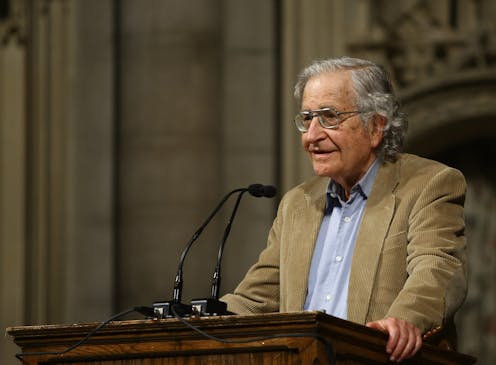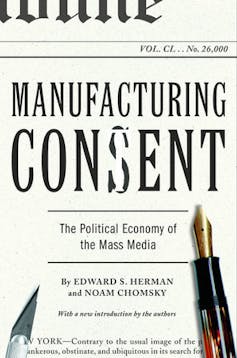Noam Chomsky at 96: The linguist, educator, philosopher and public thinker has had a massive intelle
Noam Chomsky’s notion of the human instinct for freedom ties together his many intellectual pursuits, from educating creative, independent citizens to rejecting social and economic hierarchies.

Noam Chomsky, one of the world’s most famous and respected intellectuals, will be 96 years old on Dec. 7, 2024. For more than half a century, multitudes of people have read his works in a variety of languages, and many people have relied on his commentaries and interviews for insights about intellectual debates and current events.
Chomsky suffered a stroke in June 2023 that has severely limited his movement, impaired his speech and impeded his ability to travel. His birthday provides an occasion to consider the tremendous corpus of works that he created over the years and to reflect on the many ways that his texts and recordings still critically engage with contemporary discussions all across disciplines and realms.
Chomsky’s vast body of work includes scientific research focused on language, human nature and the mind, and political writings about U.S. imperialism, Israel and Palestine, Central America, the Vietnam War, coercive institutions, the media and the many ways in which people’s needs are subjugated in the interest of profit and control.
As a scholar of humanities and law, I’ve engaged with Chomsky’s work from an array of perspectives and authored a biography called “Noam Chomsky: A Life of Dissent” and a book on Chomsky’s influence called “The Chomsky Effect: A Radical Works Beyond the Ivory Tower.” One important theme in his broad corpus is his lifelong fascination with human creativity, which helps explain his vociferous attacks on those who seek to keep the rabble in line.
Early days
Avram Noam Chomsky was born on Dec. 7, 1928, in Philadelphia. He and his younger brother, David Chomsky, were raised in a lively household by Elsie Simonofsky and William (Zev) Chomsky, progressive educators who were deeply immersed in wide-ranging Jewish and Zionist cultural activities.
Chomsky often dates his own interest in teaching and learning to his close readings of Hebrew works with his parents and to the lively educational experiences he enjoyed at the Oak Lane County Day School, an experimental school that subscribed to John Dewey’s approach to immersive learning and promoted individual creativity over competition with other students.
A precocious learner, Chomsky at 12 years old read the proofs for his father’s book about a 13th-century Hebrew grammarian named David Kimhi. It was an auspicious beginning to a life immersed in philology, philosophy and the study of language and the mind. From very early on, he sought to understand innate human propensities for freedom, dignity and creativity, which inspired his interest in fostering those properties of human nature.
While Chomsky’s parents were what he called normal Roosevelt Democrats, he was drawn to more radical approaches to society and to the promotion of noncoercive social structures. At age 10, he read about the Spanish Civil War, which inspired him to write an editorial about the fall of Barcelona for his school’s newspaper. This was an early harbinger of his public intellectual work and his vociferous challenges to systems of oppression and illegitimate authority.
As a young man, Chomsky joined a socialist wing of the Zionist youth movement that opposed a Jewish state, and from his readings and discussions he came to favor Arab-Jewish class cooperation in a socialist Palestine. His deep knowledge of Palestine and Israel, bolstered by his ability to read and speak Arabic and Hebrew, helped inform his many vehement critiques of Israeli state power.
Radical pedagogy
After an early education focused on self-discovery and free-ranging exploration, Chomsky was introduced in high school to rote learning, competition with other students and a mainstream system of values. In reaction, he began to make regular trips to New York City, where he explored bookstores. He also made regular visits with a relative who ran a newsstand on 72nd Street that served as a lively intellectual center for emigrés interested in more radical approaches to society.
In 1944, Chomsky completed high school and enrolled in the University of Pennsylvania. Although he has expressed some dismay about the structures of conformity and status quo thinking he encountered there, he did find inspiration in courses with philosopher C. West Churchman, linguist Giorgio Levi Della Vida and, moreover, linguist Zellig Harris. Chomsky knew members of the Harris family because Zellig Harris’ father hosted Jewish services in the Harris home that the Chomsky family occasionally attended.
Chomsky’s father’s approach to the study of language bore similarities to Zellig Harris’ work in Semitics, the study of Arabic, Hebrew and other Semitic languages. Harris invited Noam to read the proofs of his “Methods in Structural Linguistics.” This highly anticipated book was rooted in the idea that the function and the meaning of linguistic elements are determined by their their relationship to other components that make up sentences. After working hard to understand Harris’ linguistics paradigm, Chomsky eventually abandoned it, but he remained fascinated by Harris’ political views and by the unstructured, lively and creative debates that he promoted.
Chomsky met Carol Doris Schatz at the Hebrew School where her mother taught and Chomsky’s father was principal. Years later, when they were both students at the University of Pennsylvania, they started dating. They were married in 1949, and four years later they decided to move to an Israeli kibbutz, or communal agricultural settlement. They had expected to find a culture of creative free thinking there. Instead, they were deeply disappointed to find what Chomsky described as ideological conformity to Stalinist ideology. They returned to the U.S. after only six weeks.
The young couple settled in Boston and started a family. Noam pursued graduate work, while Carol paused her own studies to raise the children. She later returned to research on language acquisition, which she eventually taught and researched at MIT and Harvard. Carol Chomsky died in 2008. Noam remarried in 2014, to the Brazilian translator Valeria Wasserman Chomsky.
Chomskian revolution
When Chomsky was a student, most academic psychologists described human language as a system of habits, skills or dispositions to act that are acquired through extensive training, induction, generalization and association. By this account, language grows incrementally with experience, reinforced by a system of rewards and punishments.
This framework was at the heart of a structuralist paradigm, which analyzed the form and meaning of texts as different parts of the same thing. Any language, from this standpoint, restricts how phonemes and morphemes – the smallest units of sound and meaning in language – and other constituents are assembled and distributed. By this view, humans have the capacity to learn language in ways akin to how they acquire other kinds of knowledge.
Chomsky’s Ph.D. work, the resulting 1957 book “Syntactic Structures” and his New York Review of Books review of B.F. Skinner’s “Verbal Behaviour” challenged this paradigm and heralded the Chomskian linguistics revolution.
Chomsky’s starting point was that humans are endowed with universal grammar, which is activated by exposure to natural language. Children gain proficiency in a language by building on innate knowledge. This means that the capacity for language quite literally grows in the mind in a manner akin to how organs develop in the body.
Chomsky’s interest in innate human abilities draws in part from a range of philosophical treatises penned in the 17th and 18th centuries and associated with the Port Royal system of logic and Enlightenment philosophy, which emphasized science, individual liberty and the rule of law. He developed these ideas in a book called “Cartesian Linguistics,” which outlined his intellectual debt to the writings of, among others, Descartes, Kant, Rousseau and Wilhelm von Humboldt.
By the early 1960s, Chomsky’s work had gained him recognition in linguistics, philosophy and psychology. His own research, and that conducted by the growing number of linguists who adopted his approach, led to significant advances in the study of syntax, generative grammar, language and the mind, semantics, form and the interpretation of language.
His political engagement was documented in what I believe is a remarkable collection of interviews and books about U.S. imperialism, the Cold War, the Middle East, Central America and Southeast Asia, including “Problems of Knowledge and Freedom” and “For Reasons of State.” Puzzled by Americans’ spirit of resigned consensus, he began to collaborate with Edward S. Herman on books including “Counter-Revolutionary Violence,” “The Political Economy of Human Rights” and “Manufacturing Consent,” which was turned into a popular film by the same name.
Common thread
The common thread connecting Chomsky’s many intellectual projects are four “problems” that were the focus of much of his life’s work. One is Plato’s problem, which considers why it is that humans, whose contact with the world is brief and limited, can come to know so much. The second is Orwell’s complementary problem, which asks how is it that human beings know so little given the amount of information to which they have access. The third is Descartes’ problem, which pertains to the human capacity to freely express thoughts in constantly novel ways over an infinite range by means that are appropriate to circumstances but not caused by them. Finally, there’s Humboldt’s problem, which focuses on what constitutes language.
These problems are connected in different ways to how people learn, what impedes human development, and to speculations about the initial state of the language faculty, which he outlined in a range of texts, including “Knowledge of Language: Its Nature, Origin, and Use,” “Language and Problems of Knowledge: The Managua Lectures,” “The Minimalist Program” and “Why Only Us? Language and Evolution,” with Robert C. Berwick.
Chomsky’s legacy

Remarkably tenacious and active, Chomsky continued to publish and to speak out on contemporary issues into his mid-90s. His ideas evolved but were rooted in a series of deeply seated ideas about the nature of the human mind. He is one of the most cited intellectuals in history, and he was voted the leading living public intellectual in The 2005 Global Intellectuals Poll. Millions of people have watched his debates and discussions with William F. Buckley, Angela Davis, Alan Dershowitz, Michel Foucault, Howard Gardner, Christopher Hitchens, Richard Perle, Jean Piaget, Briahna Joy Gray and even Ali G.
As the figure widely viewed as the founder of cognitive sciences, Chomsky has been critical of the hype surrounding big data, artificial intelligence and ChatGPT.
As a voice for the downtrodden and the oppressed, he has spoken from the perspective of human rights, intellectual self-defense and the popular struggle through independent thinking against structures of power and subjugation.
Chomsky’s extraordinary achievements resonate far and wide – and are likely to continue to do so into the future.
Robert F. Barsky has received funding from the Rockefeller Foundation, The Guggenheim Foundation, the Social Sciences and Humanities Research Council, Fonds FCAR, and Vanderbilt University.
Read These Next
2 superpowers, 1 playbook: Why Chinese and US bureaucrats think and act alike
The men and women tasked with implementing policy are governed by the same incentives and constraints…
How rogue nations are capitalizing on gaps in crypto regulation to finance weapons programs
North Korea was behind a $1.5 billion digital bank heist in February 2025. Other countries are similarly…
A, B, C or D – grades might not say all that much about what students are actually learning
Grades can magnify inequities that exist in American schools, making it harder for some students to…





